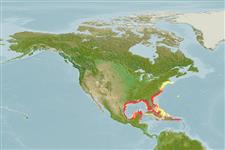>
Carangaria/misc (Various families in series Carangaria) >
Polynemidae (Threadfins)
Etymology: Polydactylus: Greek, poly = a lot of + greek, daktylos = finger (Ref. 45335).
More on author: Girard.
Environment: milieu / climate zone / depth range / distribution range
Ecologia
marinhas demersal; intervalo de profundidade 5 - 66 m (Ref. 32117), usually 5 - 16 m (Ref. 32117). Subtropical; 42°N - 18°N, 98°W - 71°E (Ref. 57343)
Western Atlantic: New York and along the coast to the western coast of Yucatán, Mexico (Ref. 57343). Some authors report this species as occurring throughout northern South America (Ref. 5217).
Comprimento de primeira maturação / Tamanho / Peso / Idade
Maturity: Lm 19.0, range 17 - 21 cm
Max length : 33.0 cm TL macho/indeterminado; (Ref. 5217); common length : 25.0 cm TL macho/indeterminado; (Ref. 5217)
Occurs on sand or mud bottoms and on beaches, especially on the surf (Ref. 57343).
Ciclo de vida ou comportamento de acasalamento
Maturidade | Reprodução | Desova | Ovos | Fecundidade | Larvas
Motomura, H., 2004. Threadfins of the world (Family Polynemidae). An annotated and illustrated catalogue of polynemid species known to date. FAO Spec. Cat. Fish. Purp. Rome: FAO. 3:117 p. (Ref. 57343)
Status na Lista Vermelha da UICN (Ref. 130435: Version 2024-1)
Ameaça para os humanos
Harmless
Uso pelos humanos
Pescarias: pouco comercial
Ferramentas
Relatórios especiais
Baixar XML
Fontes da internet
Estimates based on models
Preferred temperature (Ref.
123201): 23.3 - 27.9, mean 26.4 °C (based on 459 cells).
Índice de diversidade filogenética (Ref.
82804): PD
50 = 0.5000 [Uniqueness, from 0.5 = low to 2.0 = high].
Bayesian length-weight: a=0.00407 (0.00237 - 0.00700), b=3.07 (2.92 - 3.22), in cm total length, based on LWR estimates for this species & Genus-body shape (Ref.
93245).
Nível Trófico (Ref.
69278): 3.6 ±0.5 se; based on size and trophs of closest relatives
Resiliência (Ref.
120179): Elevada, tempo mínimo de duplicação da população menor que 15 meses (tm<1).
Fishing Vulnerability (Ref.
59153): Low vulnerability (23 of 100).
Nutrients (Ref.
124155): Calcium = 166 [72, 461] mg/100g; Iron = 1.91 [0.82, 4.18] mg/100g; Protein = 20.1 [18.3, 21.9] %; Omega3 = 0.375 [0.180, 0.781] g/100g; Selenium = 47.3 [17.0, 122.9] μg/100g; VitaminA = 3.98 [1.05, 15.64] μg/100g; Zinc = 1.04 [0.62, 1.78] mg/100g (wet weight);
